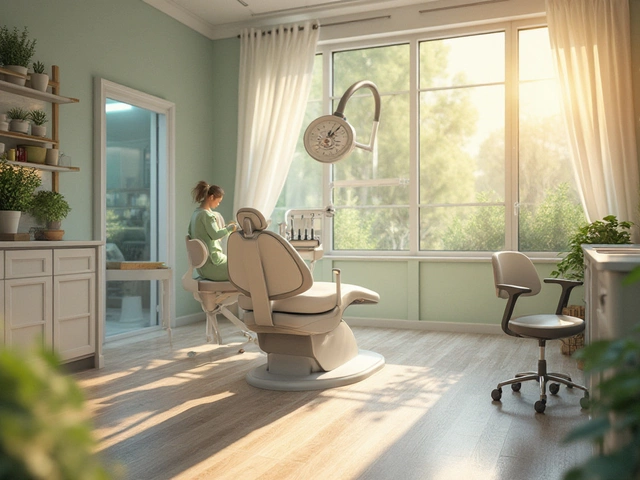In the world of telemedicine, Teladoc stands out as a popular choice for those seeking medical advice from the comfort of their own home. But it's important to know that not every issue can be resolved with an online consultation. While Teladoc doctors are qualified to diagnose and prescribe medications for a variety of conditions, there are specific limitations on what they can dispense.
This includes restrictions on controlled substances, which often require careful monitoring and evaluation that’s hard to achieve virtually. Additionally, certain lifestyle drugs and medications requiring in-depth physical assessments may not be provided. Understanding these limitations is essential for making the most of Teladoc's services and ensuring you receive the care you need efficiently and safely.
- Teladoc's Scope of Prescriptions
- Limitations on Controlled Substances
- In-Person Evaluation Requirements
- Maximizing Teladoc for Your Health Needs
Teladoc's Scope of Prescriptions
Teladoc has revolutionized access to healthcare by making it possible for patients to connect with doctors without leaving their homes. This advancement does come with certain boundaries in terms of medication prescriptions. Teladoc prescriptions generally cover a wide range of non-emergency medical conditions, like common colds, allergies, skin issues, and other basic ailments where a physical examination may not be necessary. Through virtual consultations, Teladoc physicians can assess symptoms and prescribe medications that cater to these needs, streamlining treatment for conditions that are familiar and well-documented.
However, when you dive deeper, distinct limitations emerge. While it's great for minor health issues, Teladoc positions itself to avoid prescribing medications that have significant potential for abuse or require ongoing, close evaluation. This typically means that controlled substances, which are categorized carefully by federal regulations, are off the table. These medications include opioids, benzodiazepines, and stimulants—drugs well known for their stringent prescription guidelines. For these types of medications, in-person visits are crucial not just for diagnosis, but also for ensuring patient compliance and safety in the long term.
Teladoc's policy aligns closely with industry standards. According to guidelines from the Drug Enforcement Administration, tighter control of these prescriptions is necessary to manage risks associated with misuse and addiction, which can't be effectively handled through virtual consultations. This careful approach is crucial in balancing the benefits of virtual care with patient safety. As one doctor noted in a recent telemedicine conference,
"The future of digital health hinges on maintaining trust and clinical integrity, particularly concerning medication management."The sentiment underscores Teladoc's prudence in its service offerings.
Beyond controlled substances, there are other categories of prescriptions Teladoc typically does not manage. For instance, medications for complex mental health conditions often necessitate recurring face-to-face evaluations to adjust dosages and monitor side effects properly. Lifestyle medications, such as those for erectile dysfunction or weight management, might also require physical assessments, depending on the patient's health profile. By maintaining these boundaries, Teladoc ensures that patients remain in safe hands while still benefitting from the convenience of telehealth solutions.
For patients considering Teladoc, understanding telemedicine limitations helps in setting realistic expectations. This involves reflecting on your health history and being ready to potentially visit a local healthcare provider if your medical needs exceed what Teladoc can offer. Users are encouraged to discuss their medical background openly during consultations, providing Teladoc doctors with the full spectrum of information needed to guide you appropriately. This open channel leads to better adherence to treatment plans and ultimately, healthier outcomes. In essence, from non-emergency prescriptions to immediate care inquiries, Teladoc aims to serve as an accessible bridge within the broader healthcare landscape.

Limitations on Controlled Substances
When using Teladoc for your healthcare needs, it's crucial to understand the limitations around what doctors can prescribe, especially when it comes to controlled substances. These medications, regulated by government agencies due to their potential for abuse and dependency, require stringent controls that can't always be managed in a virtual setting. This limitation isn't a reflection on the capability of telemedicine itself but rather a legal and ethical safeguard to prevent misuse and ensure patient safety.
Controlled substances encompass a broad range of medications, from pain management drugs like opioids to certain psychiatric medications. Each of these requires careful consideration, often necessitating in-person evaluations. Such assessments can be vital in determining the precise treatment plan, particularly because the potential side effects and suitability of these drugs can vary greatly between individuals. In-person visits allow for a more comprehensive appraisal of a patient's overall health and substance interaction risks.
According to the Controlled Substances Act in the United States, only practitioners registered with the DEA can prescribe these substances. This can be a limiting factor for remote consultations, as the DEA's stance has traditionally favored direct interaction between patient and provider. In virtual care, verifying the identity and history of a patient with the necessary rigor can be a challenge. The risk of diversion or misuse of these potent drugs makes it imperative to maintain stringent compliance with legal requirements.
"Physical examination provides insights that technology cannot replicate," states an expert from the Medical Board of California, underlining the challenge faced by telemedicine services.
There is also an evolving landscape of legislation and policies that could influence how these barriers change in the future. Some states have begun pilot programs to study the effectiveness of telehealth-based management for patients who require controlled substances, albeit under highly controlled conditions. As these studies progress, more dynamic frameworks for prescription might emerge, paving the way for broader access without compromising safety. For now, though, the inability to prescribe these drugs through telemedicine should encourage patients to use Teladoc for its strengths, such as chronic disease management, minor illnesses, dermatology, and nutritional consultations, where medication prescriptions play a complementary role to other treatment modalities.

In-Person Evaluation Requirements
While virtual healthcare presents significant advantages, there are scenarios demanding the tactile and immediate feedback of physical examinations. Teladoc is a robust platform that excels in providing consultations on a wide range of non-emergency health issues, but certain conditions cannot be addressed thoroughly via a screen. These are the times when an in-person evaluation becomes imperative. For instance, diagnosing conditions that require palpation, auscultation, or detailed visual inspection often necessitate face-to-face interactions. This face-to-face interaction is crucial when dealing with complex skin conditions where texture, temperature, or exact coloring play a pivotal role in the diagnosis. Often, a dermatologist will need to touch or see the condition in natural light or through special equipment to make accurate assessments.
Moreover, conditions requiring specific diagnostic tests like X-rays, MRIs, or blood tests are out of Teladoc's purview, since these procedures need appropriate facilities and technology to provide accurate results. Let’s consider musculoskeletal injuries or chronic issues such as arthritis; these often necessitate imaging studies that cannot be conducted through a digital platform. According to a 2022 study by the Journal of Telemedicine and Telecare, about 15% of telemedicine consultations result in a recommendation for an in-person visit due to the limitations inherent in virtual evaluations. Such numbers highlight the importance of not just relying solely on virtual clinics, but integrating them with traditional healthcare practices.
"Telemedicine acts as both a complement and a gateway to in-person healthcare, ensuring patients receive comprehensive and timely care," said Dr. Jordan Rivkin, a renowned telemedicine researcher.
In addition, Teladoc cannot prescribe psychiatric medications that need in-depth and continued evaluation to titrate doses accurately and safely. Mental health consultations often require a nuanced understanding of a patient's behavioral cues, stressors, and longitudinal data that might not be adequately captured in a digital format alone. This necessitates a hybrid model where initial evaluations and regular follow-ups might require access to physical facilities or direct interventions. Understanding this framework allows patients to use telemedicine judiciously, utilizing its strengths while acknowledging the situations where traditional care remains irreplaceable. For those managing chronic illnesses requiring regular feedback on symptoms and progression, an integrated approach using both telemedicine and personal visits is often recommended by healthcare professionals.
Lastly, for women’s health, particularly gynecological issues, in-person exams are frequently indispensable. Physical exams, routine PAP smears, and ultrasounds often require visits to a healthcare provider in person. These evaluations ensure thorough and preventative care that can often head off more serious issues if detected early. While online doctor consultations like those through Teladoc offer flexibility and accessibility, especially in managing follow-up appointments or discussing results, they conduct triage to determine when a patient should be referred for in-person services.

Maximizing Teladoc for Your Health Needs
When it comes to making the most out of Teladoc's offerings, a bit of strategic planning goes a long way. The convenience of virtual healthcare means you have access to medical advice from the comfort of your own home, but knowing how to maximize this tool can make a significant difference in your experience. Start by preparing for your consultation just like you would for an in-person visit. Ensure you have all your medical history handy, including symptoms you've experienced, duration, and any medications you're currently taking. This information will help the doctor make a more accurate diagnosis.
Be sure to have a strong internet connection and a quiet, private place for your consultation. Sharing sensitive health info requires a space where you can speak openly without distractions. Ask the right questions during your session. Inquire about the nature of your symptoms, possible treatments, and any follow-up actions you should take. Don't hesitate to seek clarification if you don't understand something. Remember, effective communication is key to getting the most from your Teladoc experience.
Some users find it helpful to maintain a health journal detailing symptoms, medication responses, and any changes in their condition. This provides an ongoing record that can inform future Teladoc consultations, allowing for better tracking of chronic issues. Also, you might consider periodic checks even when you're not sick to get professional insights into wellness and preventative care. Regular interactions help build rapport with Teladoc professionals, often leading to better personalized care.
A study published by the American Medical Association in 2022 found that patients who engage in regular telehealth consultations report higher satisfaction levels and health literacy. According to the study, 78% of virtual healthcare seekers appreciated the ability to discuss their health concerns more frequently and at their convenience without the hassle of travel. This reflects the growing trend towards digital health and its acceptance among users. It's an opportunity to embrace technology in everyday healthcare needs.
It's crucial to recognize limitations associated with Teladoc to avoid disappointment. For instance, if you're dealing with conditions that potentially need a physical examination or imaging tests like X-rays, be prepared for recommendations to seek in-person care. Ready access to primary care via Teladoc is an enormous advantage, but recognizing when in-person follow-up is necessary forms a part of efficient health management. Treat your virtual health sessions as you would any medical interaction, preparing comprehensively and engaging actively to harness the full potential of modern telemedicine.




